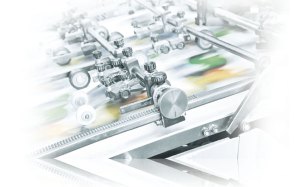Printing presses and machines for further paper processing are known to be particularly complex and are often called high-end products in mechanical engineering. These machines have a product lifetime of 25 years or even more. To keep the boards up to up to the latest technology innovations and performance, suppliers and partners for the global printing industry require an experienced partner. Today’s blog is about how a successful partnership and cooperation can result in optimized processes and future-oriented technology.
How it all began…
Around ten years ago, when the agenda of the Heidelberg Postpressincluded a new control and visualization IPC for the paper-folding machines, the firm’s specialists visited the relevant trade fairs to determine the solutions and prices available on the market. This market survey led them to Kontron as they were convinced by the product range, developers’ dedication and price concept.

So together with Kontron, in 2006, Heidelberg Postpress designed and developed a new customer-specific IPC to control the folding machines. This new unit was based on a Kontron COM Express module and a customer-specific carrier board. The computer platform was designed to optimize the operation of the new series of folding machines and to offer numerous functions from a central source. The individual control element is explicitly based on the folding machine manufacturer’s requirements. Together with a touchscreen, it was integrated directly on the machine in order to make it easier for users to operate the system while ensuring the greatest possible transparency in all workflows.
When it was time for a re-design…
The folding machines from Heidelberg Postpress have been designed to remain in use for ten years or more. Kontron guarantees their customers that subsequent delivery of spare parts and support will be readily available for a further 15 years, which adds up to a productive lifetime of 25 years and more per machine. The dilemma: Electronic components have a life cycle that cannot match this figure due to the faster development cycles in the high-tech area, which meant that at some point it was time for a re-design of the control elements that were in use, while simultaneously being able to ensure the customer a high level of continuity for existing machines.
And such a case involves much more than just a simple exchange of electronic hardware: During the re-design, the developers decided to migrate the control computer’s operating system from Windows XP to Windows 7. This also necessitated the development of new drivers and changes to the BIOS. Accordingly, the technical experts had to develop additional new software and conduct sufficient tests until the new technology could withstand its baptism of fire and be put to real use. It was also important for the new machines to work perfectly with the updated components, but even more important to guarantee that the old machines would also continue to function flawlessly after an exchange, thus performing in the manner the customer had come to expect.
Durable products to operate happily ever after
The teams of specialists developed a future-oriented control unit for the folding machines that was based on the Kontron COMe-BiP2 modules and the customer-specific B610 carrier board. A broad range of interfaces guarantees that the solution can be seamlessly integrated into the most diverse infrastructures. This ensures that the control unit operates universally. The system is also faster, which is particularly noticeable when the folding machine starts up. Due to the expanded memory, the new industrial PC furthermore allows to add new performance characteristics, which means that it is easier for customers to work with the machines. And moreover, the outward appearance of the system however has scarcely changed, which has the advantage of allowing trouble-free integration of the new unit into existing machines when an exchange is necessary, without Heidelberg Postpress having to modify or replace equipment.
The moral of the story
Although customers do not have to adjust to new operational elements, they still profit from significantly improved performance. The new touchscreen can be used to display the operating sequences, execute programs, and adjust values and performance data for convenient operation. This ultimately leads to greater transparency, which optimizes day-to-day operation.
If you want to know more about how Kontron and Heidelberg Postpress developed a high-quality control IPC to handle and coordinate its paper folding machines, you can download the detailed application story ‘Heidelberg Postpress relies on embedded technologies from Kontron’. For more information on the mentioned products, please visit the Kontron Website www.kontron.com.

{{comment.comment}}